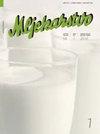Fatty acids and free amino acid composition of synbiotic goat cheese with free and encapsulated probiotics
IF 1.1
4区 农林科学
Q3 AGRICULTURE, DAIRY & ANIMAL SCIENCE
引用次数: 0
Abstract
The aim of this study was to determine the changes in free fatty acids and amino acids during storage of synbiotic microcapsule-added goat cheeses and determine the effect of microencapsulation on these changes during storage. Another objective was also to determine the effects of probiotics and synbiotics (probiotic + prebiotics) added in free form during the production of white goat cheese on amino acid and fatty acid values. In the study, three types of microcapsules including probiotic bacteria (Lacticaseibacillus casei and Bifidobacterium longum), probiotic + fructooligosaccharide (FOS), and probiotic + inulin containing microcapsules were prepared and cheeses were produced using these microcapsules. Cheese samples were stored at +4 °C for 180 days and the amino acids and free fatty acid content of the cheeses were determined during the storage period. The saturated fatty acid with the highest ratio in goat cheeses was palmitic acid (C16) whereas the unsaturated fatty acid with the highest ratio was determined as oleic acid (C18:1). At the end of ripening, the amino acid with the highest amount was glutamic acid in cheese samples, followed by leucine, proline, aspartic acid, and lysine, respectively. It has been determined that inoculation of probiotic cultures, either in free or microencapsulated form, into cheese milk positively influences the total amino acid and fatty acid levels. The addition of inulin along with probiotics on the 180th day of storage was effective in amino acid formation compared to cheeses with free FOS added. It could also be concluded that the addition of free or microencapsulated FOS was effective in the formation of free fatty acids. In addition, regardless of the used form (free or microcapsules), inulin was more effective in amino acid formation.游离和包封益生菌合成山羊奶酪的脂肪酸和游离氨基酸组成
本研究的目的是测定合成微胶囊山羊奶酪在贮藏过程中游离脂肪酸和氨基酸的变化,并确定微胶囊化对这些变化的影响。另一个目的是确定在白山羊奶酪生产过程中以自由形式添加的益生菌和合成菌(益生菌+益生元)对氨基酸和脂肪酸值的影响。本研究制备了益生菌(干酪乳杆菌和长双歧杆菌)、益生菌+低聚果糖(FOS)和益生菌+菊糖微胶囊三种类型的微胶囊,并利用这些微胶囊生产奶酪。将奶酪样品在+4℃条件下保存180 d,测定保存期间奶酪的氨基酸和游离脂肪酸含量。山羊奶酪中比例最高的饱和脂肪酸是棕榈酸(C16),而比例最高的不饱和脂肪酸是油酸(C18:1)。成熟结束时,奶酪样品中含量最高的氨基酸为谷氨酸,其次为亮氨酸、脯氨酸、天冬氨酸和赖氨酸。已经确定,在奶酪奶中接种益生菌培养物,无论是游离形式还是微胶囊形式,都对总氨基酸和脂肪酸水平产生积极影响。与添加游离FOS的奶酪相比,在贮藏第180天添加菊粉和益生菌对氨基酸形成的影响更大。也可以得出结论,添加游离或微胶囊FOS对游离脂肪酸的形成是有效的。此外,无论使用哪种形式(游离或微胶囊),菊粉都更有效地形成氨基酸。
本文章由计算机程序翻译,如有差异,请以英文原文为准。
求助全文
约1分钟内获得全文
求助全文
来源期刊

Mljekarstvo
Agricultural and Biological Sciences-Animal Science and Zoology
CiteScore
1.90
自引率
41.70%
发文量
18
审稿时长
12 weeks
期刊介绍:
Mljekarstvo is an open access, peer-reviewed international quarterly scientific journal. The first issue was published in 1951, by the Croatian Dairy Operators'' Association (today: Croatian Dairy Union, publisher). In a paper at a Union conference held 28 October 1951 in Zagreb it was said: "Our desire is that this magazine does not meet the fate of its predecessors, but that it continues to reflect the creative efforts and to provide guidelines for the producers as well as all other operators employed in the dairy industry."
It is our pleasure today to say that wishes of the enthusiasts who attended the conference have come true, and the magazine Mljekarstvo during the last six decades was a reflection of the creative efforts of numerous dairy scientists and experts, and through its texts it served as a guideline in improving production and processing of milk and dairy products. Mljekarstvo has been following all the achievements of the dairy profession in Croatia, and it also gives the short surveys of world achievements. The result of the research of local and foreign scientists and experts always find their place in the magazine Mljekarstvo. It has been edited by our outstanding dairy experts employed at colleges, research institutions and dairy companies.
 求助内容:
求助内容: 应助结果提醒方式:
应助结果提醒方式:


